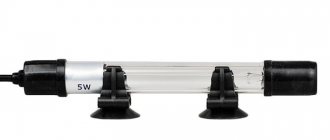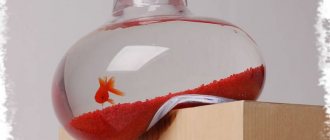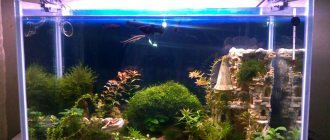The importance of aquarium light
Without light, plants will not develop. And the presence of algae in the aquarium ensures a normal level of oxygen for the life of fish and other organisms. That is why it is important to create acceptable conditions for the growth and increase in the number of sprouts of these plants:
- sufficient light intensity;
- quality of lamp light, this concept includes the characteristics of the spectrum;
- duration of exposure to lighting.
A natural light source is not enough, since it does not provide uniform illumination of the entire volume of the aquarium. And in the winter, the duration of daylight hours is much shorter, so in any case it is recommended to use artificial lighting lamps.
In addition, this option allows you to control the duration of exposure of plants to light, since with intense lighting there is an increased growth of algae, which is also undesirable.
Backlight methods
Previously, only one option with overhead placement of lamps was always used due to the fact that the lamps did not allow the use of other solutions. In addition, heating light elements created a danger with any other installation method; an additional heat removal system was needed. Thanks to LEDs, backlighting can be implemented in three different ways:
- Continuous overhead lighting. The traditional option involves placing one or more light sources on top. Moreover, lamps or diode strip can be placed both under the cover and at some distance, if a homemade version is used, and thus the light intensity is adjusted. Best suited for square or rectangular containers. Ideally, the aquarium will have one or 2-3 species of fish with similar preferences and a moderate number of plants.
- Side lighting of solid or spot type. Suitable for small-width aquariums built into furniture. In this case, the lighting comes from the back and side walls so that the light cones do not intersect in the water. It is best to use LEDs with minimum brightness or adjust it with a dimmer. This option allows you to create the effect of inverse tiers, when the lower part of the container is best illuminated, the upper part is shaded, and only reflected light reaches the bottom.
- Perimeter lighting . In this case, the LED strip is located along the vertical or horizontal edges of the aquarium. Light comes from all sides and illuminates the container normally, but there is not very much of it, which is important for many plants and fish. The method is great for aquariums with many fish and plants; it does not overload the space and can be used around the clock. And the tape consumes little electricity, so this method is also the most economical.
Perimeter lighting of the aquarium provides the most uniform light throughout the entire volume.
It is best to use rectangular or square shaped aquariums. Round or oval options are much more difficult to properly illuminate.
What is special about diode lamps
Taking into account how quickly the popularity of light sources based on LEDs is growing in various areas (external, internal lighting of objects), some time ago an attempt was made to replace lamp lighting devices with more economical analogues, in particular, with LED lamps.
LED lamp
The advantages of such light sources:
- profitability due to low energy consumption (low power allows for a sufficient level of operational efficiency);
- almost complete absence of heat from the lamp body when heated, which eliminates the need for additional cooling, and when organizing a standard lighting system based on lamp light sources, cooling is another cost item due to increased energy consumption;
- directional light flow allows you to illuminate the most important areas with plants, for comparison, in other conditions it would be necessary to use a reflector for more effective lighting;
- the ability to install light sources of the desired spectrum by connecting different combinations of diodes;
- LED lighting devices, even after long service, are not prone to changing the spectrum, unlike fluorescent versions;
- operating time, for example, most lamps used in aquariums last on average 2,000-4,000 hours, while LED analogues usually operate for 30,000-60,000 hours, depending on operating conditions.
Long service life eliminates the need for periodic lamp replacement. Arrays assembled from several LEDs can be used to illuminate aquariums. In this case, degradation (attenuation towards the end of its service life) and failure of one element will not affect the operation of the lighting device.
The main disadvantage of such lamps is their recent introduction, so there are no mass products on the market yet.
A more common practice is partial replacement of a fluorescent or other type of light source with LED analogues and their joint operation. Some craftsmen make diode-based lighting systems on their own.
The influence of different colors on aquarium fauna
Red and orange are of great importance for the photosynthesis of aquarium plants and enhance the formation of carbohydrates.
Blue and violet LEDs are needed to slow down the growth of stems. This light prevents plants from stretching out and makes them compact, which helps improve absorption. This creates a favorable environment and improves aesthetics.
The green color can be useful to give the algae a bright green color. Its rays pass completely through the leaf plates and are not absorbed. The leaf becomes thin and the stem becomes elongated due to low photosynthesis.
The yellow color is as close as possible to what it would be like in nature. The surface of the water surface does not reflect yellow rays, unlike white ones, and thereby creates natural light.
In order for the inhabitants of the aquarium to be healthy, it is necessary to correctly select both the color and intensity of lighting. It is necessary to take into account the environment in which certain species of fish lived.
For example, some residents of tropical climates do not receive bright light in wildlife even on hot sunny days. Therefore, at the genetic level, they have a low need for bright rays. Excessive lighting can cause stress and even lead to illness. Inhabitants of shallow waters with clear water, on the contrary, are light-loving. For corals that come from shallow waters, good UV radiation is important, as ultraviolet light promotes photosynthesis.
How to make the right choice?
LED lamps are selected according to two main criteria: luminous flux intensity (lm) and color temperature. For other types of light source, the determining criterion is power. Based on the value of this parameter for one lamp, you can determine the total power of the lighting system, which will be sufficient to illuminate the entire aquarium. This dependence is due to the fact that there are certain standards for compliance with lighting intensity per liter of water.
Characteristics of different types of lamps for aquarium lighting
In the case of LED backlighting, you need to be guided by lumens. These are units of measurement of luminous flux. On average, 20-40 lm is sufficient for plants, which will provide normal conditions for algae growth. The value of this parameter will be higher (40-60 lm) to illuminate more demanding plants.
The backlight in the aquarium should be characterized by a certain color temperature: from 5,500 K. Ideally, the value of this parameter should be in the range of 6,000-8,000 K. When a light source with a color temperature below 4,000 K is selected, the light will be saturated with red hues, if above 6,000 K - blue tints. The best option for an aquarium is a light source in the “warm white”, “cool white”, “daylight” design.
In addition, you should pay attention to the quality of LEDs, since cheaper Chinese crystals are distinguished by high luminescence intensity only at the initial stage of operation. After some time, LEDs will begin to degrade quickly. Therefore, it is advisable to choose higher quality lamps from trusted manufacturers.
Bottom line
And a little history: LED lighting for aquariums originated more than 10 years ago abroad. In Russia, this direction began to develop not so long ago.
Several companies producing equipment based on halogen lamps have decided to introduce more economical and safe LEDs into production. And it seems they succeeded.
Lighting with LED lamps is a promising direction. After all, LED lighting can be used not only in aquariums. There are many areas where such ideas can be used.
Lamp spectrum selection
There is always a debate among aquariumists about the choice of spectrum. It is especially fueled by advertisements about the need to use the very, very best spectrum of a particular company.
As stated above, there is no spectrum that “helps” plants and “hurts” algae. If you have a fairly “good” spectrum, then intensity is more important to you than spectrum. If you have enough light, then the spectrum is not very important, and if you do not have light, then the spectrum will not help you. This is also evidenced by the successful cultivation of plants under the light of conventional lamps - LB (Coolwhite) or a combination of LB/LD (coolwhite/daylight) with electric lamps.
Advantages and disadvantages of LED strip for aquarium lighting
Most often, LED strip is used to illuminate an aquarium, and this has its advantages:
- LEDs do not generate heat during operation. This is a significant advantage compared to conventional incandescent lamps and other types of lamps. Thanks to this, the water does not overheat and there are no conditions for the development of pathogenic microorganisms. Algae, fish and other inhabitants of the aquarium live longer and do not get sick, and the owner of the tank can always enjoy the beauty of this little world.
- Thanks to LEDs, aquarium lighting is maintained around the clock. Modern programmable devices independently determine the time of day using a light sensor and, when required, turn the lamps on or off, setting them to the appropriate brightness.
- LED waterproof lamps (class IP-65) are not affected by water and remain operational for an almost unlimited period of time.
- LED aquarium lights are completely safe and economical. They operate under direct current and a voltage of no more than 12 volts, generated by a power supply from a standard household network. Therefore, short circuits and the danger of electric shock during their operation are not dangerous either for the inhabitants of the aquarium or for its owners.
- LEDs are more economical and durable than incandescent lamps. With the same light power, they consume 10 times less energy. In addition, they do not burn out and last up to 100 thousand hours.
- Wide range of colors. Lamps emit in all possible ranges of the visible spectrum of light radiation. This allows you to solve any bold design ideas and give the small underwater world truly unsurpassed unique artistic touches in the design.
- LED strips, lamps, spotlights, matrices, individual LEDs are easy to install. Some models are equipped with a self-adhesive backing specifically for this purpose.
- LEDs do not contain harmful substances and do not produce ultraviolet, infrared and other harmful radiation.
Of course, like any other lighting system, LED aquarium lighting is not without its drawbacks. This is primarily the high cost. If you take into account all the advantages, then such a minus easily pays off. Another drawback is the need to select lighting conditions. However, this is typical for any aquarium lighting system.
To benefit from light for underwater flora and fauna, you need to be patient, begin to observe and note all the processes that occur, building patterns from them for better growth of plants, fish and other organisms. For example, if after installing lamps in water, plants begin to grow, but are not sufficiently developed, then there is not enough light, the lighting intensity needs to be added or the color changed.
https://youtube.com/watch?v=2GzkJgGj_28











